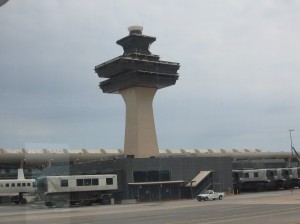By Nicholas Kralev
The Washington Times
June 1, 2009
Feeling bitter while traveling and complaining about things you can’t change is never healthy, but I couldn’t help doing just that last week as a trip to Hong Kong and Singapore reminded me how unfortunate we are to have to put up with Washington Dulles International Airport.
Through the years, I’ve tried to accept the reality of the Dulles experience by making it a routine that requires little thinking — from the lack of decent First World transportation to the airport and the archaic people-movers there officially known as “mobile lounges” to the depressing interior of the “midfield terminal” and the immigration hall that is anything but welcoming.
I’ve also defended Dulles when I’ve heard people around the world call it one of the worst airports they have seen. After all, when it was built in the early 1960s, architects apparently considered the design rather innovative, and the main terminal was viewed as an impressive structure. According to the Web site of the Metropolitan Washington Airport Authority (MWAA), which manages Dulles, “it was the first U.S. airport built for commercial jet aircraft” when it first opened 47 years ago.
The main problem today is that the airport’s infrastructure and functionality haven’t kept up with the basic demands of modern air travel. It took its management a long time to realize that, and it’s taking it much longer to do something about it.
By the late 1990s, Dulles “was the fastest-growing airport in the country,” at a rate of more than 25 percent a year, while the average national rate was less than 3 percent, also according to the MWAA’s site. It surpassed the 20 million-passenger mark in 2000 and topped 23 million six years later.
Yet not much has changed for passengers in more than two decades. The midfield terminal, which houses the C and D concourses used mainly by United Airlines, was supposed to be a temporary facility when it was built in the mid-1980s. Its replacement “has been deferred indefinitely,” said MWAA spokeswoman Courtney Mickalonis.
To be fair, there have been some recent improvements, including a new air-traffic-control tower, a fourth runway, a tunnel between the main terminal and the A and B concourses, and an expansion of the B concourse.
However, one only needs to experience airports such as those in Hong Kong and Singapore to realize that Dulles is still considerably behind the times. Those two airports consistently top various global rankings, but there are many others that would easily shame Dulles, including much smaller domestic ones. John Wayne Airport in California’s Orange County comes to mind.
“The transfer tank-shuttle to the [Dulles] midfield terminal is an embarrassment to an airport of this century, leaving the impression of a Third World country to visitors and potential investors, let alone political representatives,” said Sebastian Poggel, a travel consultant who spends most of his time on the road.
The mobile lounges may soon be a thing of the past, where they rightfully belong. An “aerotrain” is expected to begin transporting passengers between concourses later this year, although a date has yet to be announced.
Leaving aside the superior design, convenience and functionality of other airports, there are two deficiencies that bother me most about Dulles.
The first doesn’t depend only on the MWAA, but on local governments as well. It’s the lack of reasonable and timely public transportation to and from the airport. Unless you drive, your only options are a taxi, which will cost you at least $60 each way, or a shared ride on the SuperShuttle — for half that money but double the time. The long-planned Metrorail extension to Dulles is not expected for years.
In Hong Kong, where the airport is about the same distance from the city as Dulles is from Washington, I paid $13 for a 24-minute train ride last week. A taxi would have cost me $30. It took me 50 minutes to get to the city from the time I got off the plane. That included going through immigration and waiting for the train the maximum 12 minutes.
At Dulles, you could wait up to two hours in the immigration line in a depressing environment lacking natural light, which is the second thing that bothers me most. “The immigration facilities are not able to keep up with the masses of arriving international passengers,” Mr. Poggel said.
The MWAA is planning to expand the immigration-and-customs area “to serve approximately 2,400 passengers per hour — nearly double that of its current capacity. Baggage claim devices will be enlarged and new primary inspection positions will be added,” the authority says on its Web site.
“Skylights and a large window area will allow natural light to filter into the space, providing a more welcoming entry to the United States,” it says, estimating the project’s completion in 2011.
This column was first published by The Washington Times


One comment